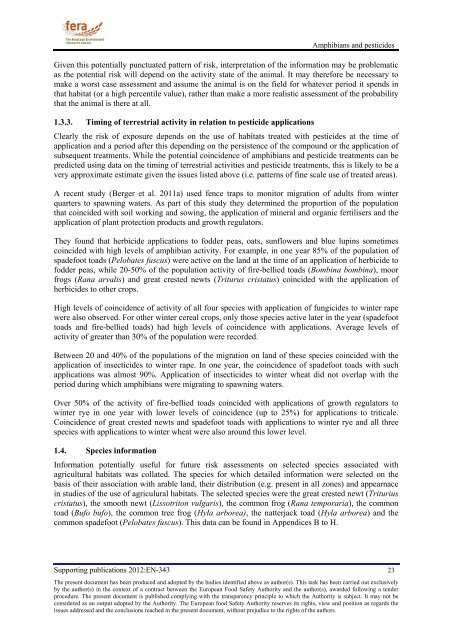The exposure and toxicity of pesticides to amphibians
The exposure and toxicity of pesticides to amphibians
The exposure and toxicity of pesticides to amphibians
You also want an ePaper? Increase the reach of your titles
YUMPU automatically turns print PDFs into web optimized ePapers that Google loves.
Amphibians <strong>and</strong> <strong>pesticides</strong><br />
Given this potentially punctuated pattern <strong>of</strong> risk, interpretation <strong>of</strong> the information may be problematic<br />
as the potential risk will depend on the activity state <strong>of</strong> the animal. It may therefore be necessary <strong>to</strong><br />
make a worst case assessment <strong>and</strong> assume the animal is on the field for whatever period it spends in<br />
that habitat (or a high percentile value), rather than make a more realistic assessment <strong>of</strong> the probability<br />
that the animal is there at all.<br />
1.3.3. Timing <strong>of</strong> terrestrial activity in relation <strong>to</strong> pesticide applications<br />
Clearly the risk <strong>of</strong> <strong>exposure</strong> depends on the use <strong>of</strong> habitats treated with <strong>pesticides</strong> at the time <strong>of</strong><br />
application <strong>and</strong> a period after this depending on the persistence <strong>of</strong> the compound or the application <strong>of</strong><br />
subsequent treatments. While the potential coincidence <strong>of</strong> <strong>amphibians</strong> <strong>and</strong> pesticide treatments can be<br />
predicted using data on the timing <strong>of</strong> terrestrial activities <strong>and</strong> pesticide treatments, this is likely <strong>to</strong> be a<br />
very approximate estimate given the issues listed above (i.e. patterns <strong>of</strong> fine scale use <strong>of</strong> treated areas).<br />
A recent study (Berger et al. 2011a) used fence traps <strong>to</strong> moni<strong>to</strong>r migration <strong>of</strong> adults from winter<br />
quarters <strong>to</strong> spawning waters. As part <strong>of</strong> this study they determined the proportion <strong>of</strong> the population<br />
that coincided with soil working <strong>and</strong> sowing, the application <strong>of</strong> mineral <strong>and</strong> organic fertilisers <strong>and</strong> the<br />
application <strong>of</strong> plant protection products <strong>and</strong> growth regula<strong>to</strong>rs.<br />
<strong>The</strong>y found that herbicide applications <strong>to</strong> fodder peas, oats, sunflowers <strong>and</strong> blue lupins sometimes<br />
coincided with high levels <strong>of</strong> amphibian activity. For example, in one year 85% <strong>of</strong> the population <strong>of</strong><br />
spadefoot <strong>to</strong>ads (Pelobates fuscus) were active on the l<strong>and</strong> at the time <strong>of</strong> an application <strong>of</strong> herbicide <strong>to</strong><br />
fodder peas, while 20-50% <strong>of</strong> the population activity <strong>of</strong> fire-bellied <strong>to</strong>ads (Bombina bombina), moor<br />
frogs (Rana arvalis) <strong>and</strong> great crested newts (Triturus cristatus) coincided with the application <strong>of</strong><br />
herbicides <strong>to</strong> other crops.<br />
High levels <strong>of</strong> coincidence <strong>of</strong> activity <strong>of</strong> all four species with application <strong>of</strong> fungicides <strong>to</strong> winter rape<br />
were also observed. For other winter cereal crops, only those species active later in the year (spadefoot<br />
<strong>to</strong>ads <strong>and</strong> fire-bellied <strong>to</strong>ads) had high levels <strong>of</strong> coincidence with applications. Average levels <strong>of</strong><br />
activity <strong>of</strong> greater than 30% <strong>of</strong> the population were recorded.<br />
Between 20 <strong>and</strong> 40% <strong>of</strong> the populations <strong>of</strong> the migration on l<strong>and</strong> <strong>of</strong> these species coincided with the<br />
application <strong>of</strong> insecticides <strong>to</strong> winter rape. In one year, the coincidence <strong>of</strong> spadefoot <strong>to</strong>ads with such<br />
applications was almost 90%. Application <strong>of</strong> insecticides <strong>to</strong> winter wheat did not overlap with the<br />
period during which <strong>amphibians</strong> were migrating <strong>to</strong> spawning waters.<br />
Over 50% <strong>of</strong> the activity <strong>of</strong> fire-bellied <strong>to</strong>ads coincided with applications <strong>of</strong> growth regula<strong>to</strong>rs <strong>to</strong><br />
winter rye in one year with lower levels <strong>of</strong> coincidence (up <strong>to</strong> 25%) for applications <strong>to</strong> triticale.<br />
Coincidence <strong>of</strong> great crested newts <strong>and</strong> spadefoot <strong>to</strong>ads with applications <strong>to</strong> winter rye <strong>and</strong> all three<br />
species with applications <strong>to</strong> winter wheat were also around this lower level.<br />
1.4. Species information<br />
Information potentially useful for future risk assessments on selected species associated with<br />
agricultural habitats was collated. <strong>The</strong> species for which detailed information were selected on the<br />
basis <strong>of</strong> their association with arable l<strong>and</strong>, their distribution (e.g. present in all zones) <strong>and</strong> appearnace<br />
in studies <strong>of</strong> the use <strong>of</strong> agriculural habitats. <strong>The</strong> selected species were the great crested newt (Triturius<br />
cristatus), the smooth newt (Lissotri<strong>to</strong>n vulgaris), the common frog (Rana temporaria), the common<br />
<strong>to</strong>ad (Bufo bufo), the common tree frog (Hyla arborea), the natterjack <strong>to</strong>ad (Hyla arborea) <strong>and</strong> the<br />
common spadefoot (Pelobates fuscus). This data can be found in Appendices B <strong>to</strong> H.<br />
Supporting publications 2012:EN-343 23<br />
<strong>The</strong> present document has been produced <strong>and</strong> adopted by the bodies identified above as author(s). This task has been carried out exclusively<br />
by the author(s) in the context <strong>of</strong> a contract between the European Food Safety Authority <strong>and</strong> the author(s), awarded following a tender<br />
procedure. <strong>The</strong> present document is published complying with the transparency principle <strong>to</strong> which the Authority is subject. It may not be<br />
considered as an output adopted by the Authority. <strong>The</strong> European food Safety Authority reserves its rights, view <strong>and</strong> position as regards the<br />
issues addressed <strong>and</strong> the conclusions reached in the present document, without prejudice <strong>to</strong> the rights <strong>of</strong> the authors.

















